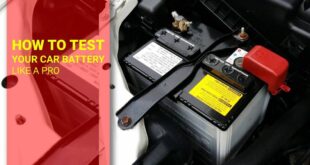The car alternator could be the cause of your car refusing to start. But before changing it, it is better to check if it is the source of the problem and not the starter or simply the battery. Many questions have been coming in on how to test an alternator when the car won’t start.
How to test an alternator
Some newer vehicles may have computer-controlled charging systems and would require additional testing. In the course of this blog, we will be discussing how to test car alternator easily.
1- Using a Voltmeter, Tester or Multimeter
If you have a multimeter, then this is how to test a car alternator with a multimeter. This is a well-known technique to test an alternator, these devices are very important, and it is good that you have a multimeter available. You can also get a regulator and look for ways to test a car alternator with regulators.
You can buy a voltmeter.
You can find one at any store that sells auto parts or electronics for less than $ 20. Don’t worry about getting an expensive one; a cheap voltmeter will do for this purpose. If you want, you can also choose to buy one on Amazon.
Check the battery first.
The battery is necessary to start the car, and in turn, it causes the alternator to turn at speed sufficient to keep the battery charged. This means that if the battery has a low charge, it will not be able to start the car, and, therefore, you will still not be able to test the alternator; any additional tester tests will be totally useless.
If the weather is cold or your battery is old, the battery could be the problem, and your alternator could be fine. For that reason, it is a good idea to do a battery test before you get ready to check the alternator.
How to do it:
- Turn off the car and make sure the engine is off before making the tester connection.
- Open the hood.
- Connect the multimeter to the battery, place the red lead from the tester on the positive battery terminal, and then put the black lead on the negative terminal.
- Read the voltmeter. If the battery reads above 12.2 volts, it has enough power to start the alternator, which can then be tested with the voltmeter.
- If the battery does not have the required voltage, charge the battery and retest it again or try a different technique to test the alternator.
2- Monitoring your alternator
If you have a volt/amp meter, it will read the alternator output for you. Run the engine at 2,000 rpm for testing and turn on the AC fan or heater, headlights, and any other accessories that force the alternator, and watch the meter to see if voltage or amperage drops.
As a general rule, if the voltmeter is higher when the engine is running, then it can be safely assumed that the alternator is charging when the engine is not.
Listen to the alternator while the engine is running.
If there is a problem with the bearings, you may hear a screeching sound coming from the front of the vehicle, which is louder with more electrical accessories and eats up the power in parallel.
Turn on its stereo and rev the engine.
Tune your radio to a low number on the AM band without music. If you ever hear the radio moaning or becoming inaccurate every time you hit the throttle, this is one of the symptoms of a car charging system failure.
Find a place where they test car alternators for free.
Since every store would love for you to buy your new alternator from them, many will try to get the upper hand over their competitors by offering free trials. Take apart your alternator and bring it in to be safe. This is how you can test an alternator for free.



